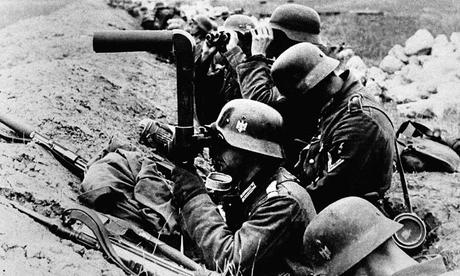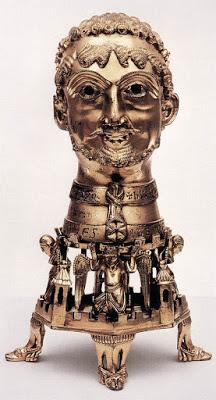Operation Poomalai was the codename assigned to the mission undertaken by the Indian Air Force to air-drop supplies over the besieged town of Jaffna in Sri Lanka on 4 June 1987 in support of Tamil Tigers during the Sri Lankan Civil War.Yazhpanam (Jaffna) was at the time under blockade by Sri Lankan troops as a part of Colombo's offensive against the Tamil separatist movement.
 Operation Barbarossa was the code name for the Axis invasion of
the Soviet Union, which started on Sunday, 22 June 1941, during World War II.
The operation stemmed from Nazi Germany's ideological aims to conquer the
western Soviet Union so that it could be repopulated by Germans (Lebensraum),
to use Slavs as a slave labor force for the Axis war effort and to annihilate
the rest according to Generalplan Ost, and to acquire the oil reserves of the
Caucasus and the agricultural resources of Soviet territories. Operationally,
German forces achieved major victories and occupied some of the most important
economic areas of the Soviet Union (mainly in Ukraine) and inflicted, as well
as sustained, heavy casualties. Despite these Axis successes, the German
offensive stalled in the Battle of Moscow at the end of 1941, and the
subsequent Soviet winter counteroffensive pushed German troops back. The
failure of Operation Barbarossa proved a turning point in the fortunes of the
Third Reich.
The Corpus Juris ("Body of Civil Law") is the modern
name for a collection of fundamental works in jurisprudence, issued from 529 to
534 by order of Justinian I, Eastern Roman Emperor. It is also sometimes
referred to as the Code of Justinian, although this name belongs more properly
to the part titled Codex Justinianus. The Corpus
Juris Civilis was revised into Greek, when that became the predominant language
of the Eastern Roman Empire, and continued to form the basis of the empire's
laws The Corpus continues to have a major influence on public international
law.
Frederick
I (1122 – 10 June 1190), also known as Frederick Barbarossa was the Holy Roman
Emperor from 2 January 1155 until his death. He was elected King of Germany at
Frankfurt in Mar 1152 and crowned.He was
crowned King of Italy in 1155 in Pavia and emperor by Pope in the same
year.He was later formally crowned King
of Burgundy, at Arles. He was named Barbarossa by the northern Italian cities
which he attempted to rule: Barbarossa means "red beard" in Italian.
Historians
consider him among the Holy Roman Empire's greatest medieval emperors. He
combined qualities that made him appear almost superhuman to his
contemporaries: his longevity, his ambition, his extraordinary skills at
organization, his battlefield acumen and his political perspicacity. Frederick
died in 1190 in Asia Minor while leading an army in the Third Crusade.
Operation Barbarossa was the code name for the Axis invasion of
the Soviet Union, which started on Sunday, 22 June 1941, during World War II.
The operation stemmed from Nazi Germany's ideological aims to conquer the
western Soviet Union so that it could be repopulated by Germans (Lebensraum),
to use Slavs as a slave labor force for the Axis war effort and to annihilate
the rest according to Generalplan Ost, and to acquire the oil reserves of the
Caucasus and the agricultural resources of Soviet territories. Operationally,
German forces achieved major victories and occupied some of the most important
economic areas of the Soviet Union (mainly in Ukraine) and inflicted, as well
as sustained, heavy casualties. Despite these Axis successes, the German
offensive stalled in the Battle of Moscow at the end of 1941, and the
subsequent Soviet winter counteroffensive pushed German troops back. The
failure of Operation Barbarossa proved a turning point in the fortunes of the
Third Reich.
The Corpus Juris ("Body of Civil Law") is the modern
name for a collection of fundamental works in jurisprudence, issued from 529 to
534 by order of Justinian I, Eastern Roman Emperor. It is also sometimes
referred to as the Code of Justinian, although this name belongs more properly
to the part titled Codex Justinianus. The Corpus
Juris Civilis was revised into Greek, when that became the predominant language
of the Eastern Roman Empire, and continued to form the basis of the empire's
laws The Corpus continues to have a major influence on public international
law.
Frederick
I (1122 – 10 June 1190), also known as Frederick Barbarossa was the Holy Roman
Emperor from 2 January 1155 until his death. He was elected King of Germany at
Frankfurt in Mar 1152 and crowned.He was
crowned King of Italy in 1155 in Pavia and emperor by Pope in the same
year.He was later formally crowned King
of Burgundy, at Arles. He was named Barbarossa by the northern Italian cities
which he attempted to rule: Barbarossa means "red beard" in Italian.
Historians
consider him among the Holy Roman Empire's greatest medieval emperors. He
combined qualities that made him appear almost superhuman to his
contemporaries: his longevity, his ambition, his extraordinary skills at
organization, his battlefield acumen and his political perspicacity. Frederick
died in 1190 in Asia Minor while leading an army in the Third Crusade.
 The
reigns of Henry IV and Henry V left the status of the German empire in
disarray, its power waning under the weight of the Investiture controversy. For
a quarter of a century following the death of Henry V in 1125, the German
monarchy was largely a nominal title with no real power.The king was chosen by
the princes, was given no resources outside those of his own duchy, and he was
prevented from exercising any real authority or leadership in the realm. The
royal title was furthermore passed from one family to another to preclude the
development of any dynastic interest in the German crown. When Frederick I of
Hohenstaufen was chosen as king in 1152, royal power had been in effective
abeyance for over twenty-five years, and to a considerable degree for more than
eighty years. The Germany that Frederick tried to unite was a patchwork of more
than 1600 individual states, each with its own prince. A few of these, such as
Bavaria and Saxony, were large. Many were too small to pinpoint on a map.Eager
to restore the Empire to the position it had occupied under Charlemagne and
Otto I the Great, the new king saw clearly that the restoration of order in
Germany was a necessary preliminary to the enforcement of the imperial rights
in Italy. Frederick undertook six expeditions into Italy. Frederick was focused
on restoring peace in the Rhineland, where he organized a magnificent
celebration of the canonization of Charles the Great (Charlemagne) at
Aachen.In a move to consolidate his reign after the
disastrous expedition into Italy, Frederick was formally crowned King of
Burgundy at Arles in June 1178. Although
traditionally the German kings had automatically inherited the royal crown of
Arles since the time of Conrad II, Frederick felt the need to be crowned by the
Archbishop of Arles, regardless of his laying claim to the title from 1152.
On
10 June 1190, Emperor Frederick Barbarossa drowned near Silifke Castle in the
Saleph river. By one chronicle, Frederick
was thrown from his horse and the shock of the cold water caused him to have a
heart attack. Frederick's death caused several thousand German soldiers to
leave the force and return home through the Cilician and Syrian ports. The
German-Hungarian army was struck with an onset of disease near Antioch,
weakening it further.
The
increase in wealth of the trading cities of northern Italy led to a revival in
the study of the Justinian Code, a Latin legal system that had become extinct
centuries earlier. Frederick became the
subject of many legends, including that of a sleeping hero, like the much older
British Celtic legends of Arthur or Bran the Blessed. Frederick's first
marriage, to Adelheid of Vohburg, did not produce any children and was
annulled. From his second marriage, to Beatrice of Burgundy,he had 11children.
Operation Barbarossa - the code name for the Axis invasion of
the Soviet Union, which started on Sunday, 22 June 1941, during World War
II,was named after medieval Emperor
Frederick Barbarossa of the Holy Roman Empire.He died on this day (June 10) in 1190.
With regards – S. Sampathkumar
10th June 2019.
The
reigns of Henry IV and Henry V left the status of the German empire in
disarray, its power waning under the weight of the Investiture controversy. For
a quarter of a century following the death of Henry V in 1125, the German
monarchy was largely a nominal title with no real power.The king was chosen by
the princes, was given no resources outside those of his own duchy, and he was
prevented from exercising any real authority or leadership in the realm. The
royal title was furthermore passed from one family to another to preclude the
development of any dynastic interest in the German crown. When Frederick I of
Hohenstaufen was chosen as king in 1152, royal power had been in effective
abeyance for over twenty-five years, and to a considerable degree for more than
eighty years. The Germany that Frederick tried to unite was a patchwork of more
than 1600 individual states, each with its own prince. A few of these, such as
Bavaria and Saxony, were large. Many were too small to pinpoint on a map.Eager
to restore the Empire to the position it had occupied under Charlemagne and
Otto I the Great, the new king saw clearly that the restoration of order in
Germany was a necessary preliminary to the enforcement of the imperial rights
in Italy. Frederick undertook six expeditions into Italy. Frederick was focused
on restoring peace in the Rhineland, where he organized a magnificent
celebration of the canonization of Charles the Great (Charlemagne) at
Aachen.In a move to consolidate his reign after the
disastrous expedition into Italy, Frederick was formally crowned King of
Burgundy at Arles in June 1178. Although
traditionally the German kings had automatically inherited the royal crown of
Arles since the time of Conrad II, Frederick felt the need to be crowned by the
Archbishop of Arles, regardless of his laying claim to the title from 1152.
On
10 June 1190, Emperor Frederick Barbarossa drowned near Silifke Castle in the
Saleph river. By one chronicle, Frederick
was thrown from his horse and the shock of the cold water caused him to have a
heart attack. Frederick's death caused several thousand German soldiers to
leave the force and return home through the Cilician and Syrian ports. The
German-Hungarian army was struck with an onset of disease near Antioch,
weakening it further.
The
increase in wealth of the trading cities of northern Italy led to a revival in
the study of the Justinian Code, a Latin legal system that had become extinct
centuries earlier. Frederick became the
subject of many legends, including that of a sleeping hero, like the much older
British Celtic legends of Arthur or Bran the Blessed. Frederick's first
marriage, to Adelheid of Vohburg, did not produce any children and was
annulled. From his second marriage, to Beatrice of Burgundy,he had 11children.
Operation Barbarossa - the code name for the Axis invasion of
the Soviet Union, which started on Sunday, 22 June 1941, during World War
II,was named after medieval Emperor
Frederick Barbarossa of the Holy Roman Empire.He died on this day (June 10) in 1190.
With regards – S. Sampathkumar
10th June 2019.

